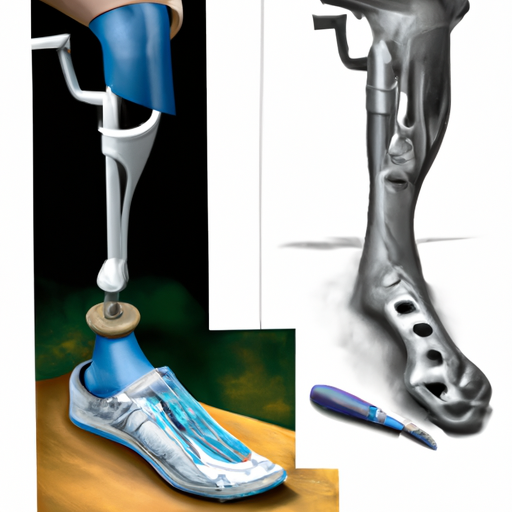
A total ankle replacement (TAR) is a surgical procedure to replace a diseased or damaged ankle joint with an artificial implant. While this type of surgery is usually reserved for patients with advanced arthritis, there are other factors that can contribute to the decision to move forward with TAR. In this blog post, we'll explore when to consider a total ankle replacement and some of the factors involved in making the decision.
Living with arthritis in your ankle can be difficult, especially when it significantly reduces how active you can be and your quality of life. It might mean having to give up certain sports or activities that you once enjoyed doing. However, arthritis does not have to be a life sentence for complete inactivity. With the right medical treatment and lifestyle changes, it is possible to find ways of living a comfortable life despite chronic arthritis-related pain in your ankle. Additionally, research has shown that physical activity is vital for people with arthritis as it helps keep joints flexible and strengthen muscles surrounding them. There are low impact options that can still help you stay fit while being easier on your ankle--such as swimming or yoga--that may provide an opportunity to continue to exercise without any further damage caused by arthritis.
When arthritis has progressed and conservative treatments like physical therapy or steroid injections have not worked, it can be discouraging. At this point, it is time to seek alternative treatments that are backed by healthcare research and can really make a difference in your arthritis symptoms. With the right approach, you can help reduce pain and even enjoy activities again without arthritis getting in the way. Consulting with an arthritis specialist or orthopaedic surgeon is the best way to start as they will recommend an individualized plan that is tailored specifically to your needs and abilities.
Dealing with ankle arthritis can be a trying experience that affects your ability to move about. Ongoing ankle pain often interferes with daily activities and exercise, making it difficult to maintain an active lifestyle. In fact, some studies suggest that end stage ankle arthritis can be more debilitating than end stage hip arthritis. Fortunately, there are options that can help provide relief from the symptoms of ankle arthritis. Physical therapy is a great way to reduce inflammation in the ankle joint and strengthen the surrounding muscles. Additionally, medications prescribed by your doctor can manage pain and inflammation. Taking time for relaxation activities such as yoga or meditation can also be beneficial in managing stress and muscle tension around the ankle joint. With its various causes, ankle arthritis is somewhat unpredictable in its severity, but working with your healthcare provider can help you develop a treatment plan to manage symptoms and live an active lifestyle!
When you suffer a fracture or a painful ankle arthritis-related injury, the aftermath can often be quite debilitating. The importance of proper healing and rehabilitation cannot be understated - if an injury hasn't mended correctly, additional pain and irritation is highly likely to occur. Seeking the advice of a qualified medical professional to ensure that all the necessary steps are taken for recovery is absolutely essential; it may mean taking medications, using braces to support weight-bearing, or having further treatments such as physiotherapy or even surgery. Taking proactive steps to ensure fast and full healing is always recommended.
When ankle arthritis occurs, the joint can become so stiff and uncomfortable that even everyday activities such as walking, jogging, and dancing can become difficult. A deformity in your ankle joint can be both painful and disabling, making it difficult to live a life of freedom and movement. Treatment plans may focus on reducing pain, increasing mobility, and improving ankle strength. Long-term strategies include lifestyle changes such as weight loss, limiting high-impact exercises, ankle bracing or taping to support the joint, or other forms of physical therapy. While ankle arthritis can be a challenging condition to live with, focusing on maintaining flexibility and strength protocols is the best way to ensure a healthy ankle joint overall.
Having ankle arthritis can be painful and debilitating, but if you're generally healthy, surgery and rehabilitation can improve your quality of life. Surgery offers the potential to reduce pain and minimize disability by providing joint mobility and allowing normal weight-bearing forces to be shared across the ankle joint. Postoperative rehabilitation is important and allows patients to return back to functional activities with greater confidence. With careful management before, during, and after surgery, individuals with ankle arthritis can expect a satisfactory result and improved ankle function after their treatment.
As we have discussed, there are a number of conditions that can cause chronic ankle pain and limit your ability to participate in activities. Traditional treatments like physical therapy and steroids may provide some relief, but more invasive methods may be an option if these don’t work. When you have arthritis in your ankle, a fracture or injury that has not healed properly, or a deformity in the joint, surgical intervention may be necessary. Of course, it is important to take into account the overall health and fitness of the patient when considering surgery as an option.
If you feel that despite conservative means your pain is still persistent, it could be time to speak with an orthopaedic foot and ankle surgeon about potential solutions. A qualified doctor will have many years’ worth of expertise under their belt and should be able to provide insight into which invasive treatments are appropriate for reducing pain caused by chronic ankle injuries and conditions. Don't wait too long: get the help you need today!